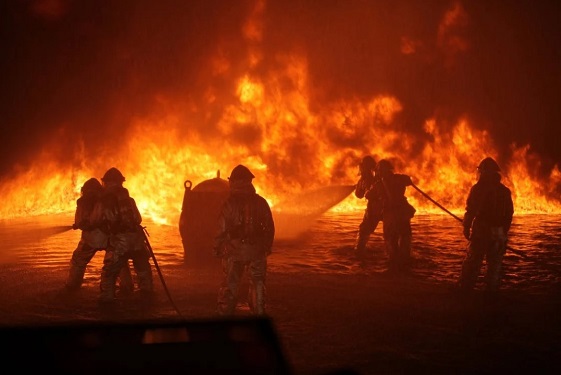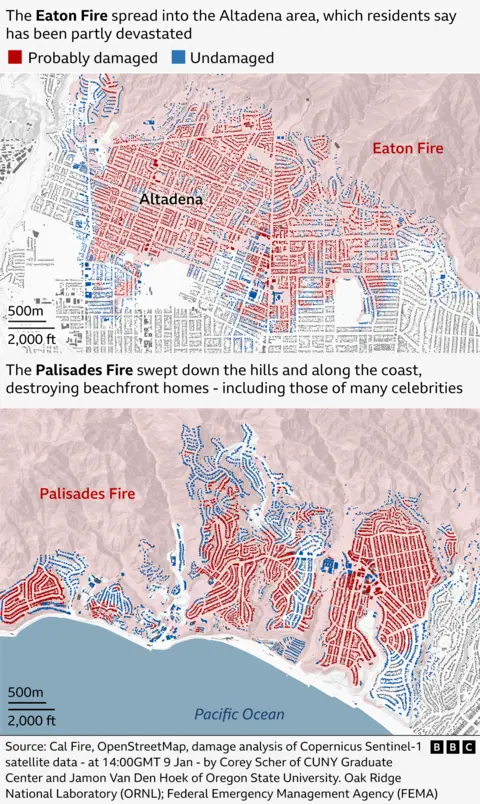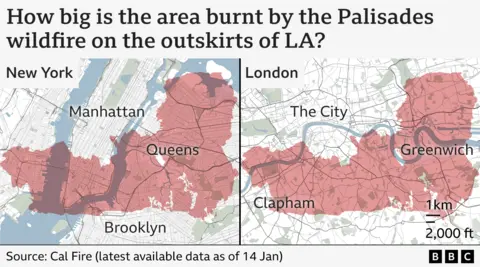At least 25 people have died in the Los Angeles fires as two major blazes continue to burn across the sprawling US city.
Firefighters made progress over the weekend in containing the Palisades and Eaton fires but warn that the return of high winds - forecast until Wednesday - could see these two spread again, or fuel new ones.
The fires are already among the most destructive in LA's history when measured by the number of buildings destroyed. Rebuilding work will cost "tens of billions" of dollars, US President Joe Biden has said.
What's the latest?
A red flag warning - indicating a high level of fire danger - is in place until 18:00 (02:00 GMT) on Wednesday, with the strongest Santa Ana winds expected on Tuesday.
Nearby, the largest fire is in the Palisades area, and has burnt through more than 23,000 acres. It is still only about 14% contained, despite the efforts of thousands of firefighters.
The blaze is moving east, threatening the exclusive neighbourhood of Brentwood, home to the Getty Center, a world-famous art museum that has evacuated its staff.
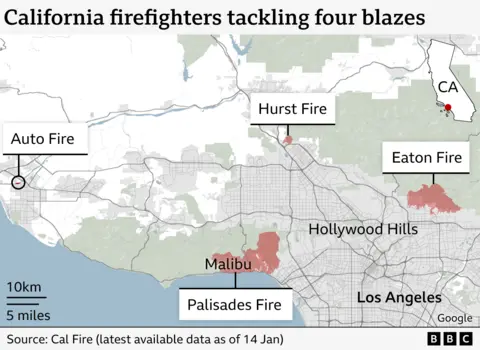
Another fire, Eaton, is more deadly than Palisades so far - responsible for 16 of the deaths.
The overall destruction is immense, with more than 12,000 structures - homes, outbuildings, sheds, mobile homes and cars - destroyed. Celebrities Mel Gibson and Paris Hilton are among those who have lost their homes.
Tens of thousands of homes are also without power.
The fires could turn out to be the costliest in US history, with damage projected at up to $150bn, according to a preliminary estimate by AccuWeather.
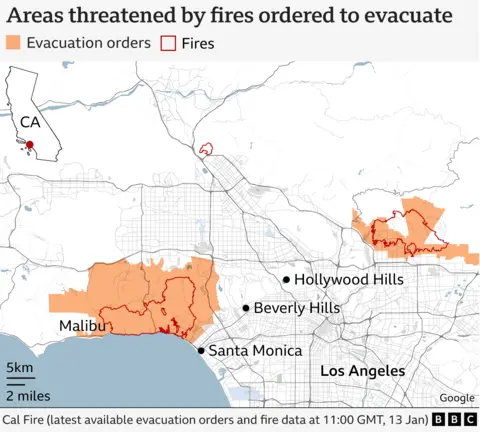
What caused the fires?
Lightning - the most common source of fires in the US - has been ruled out as a cause for the Palisades and Eaton fires.
There has been no official indication so far that arson or utility lines - the next two biggest culprits in sparking fires - caused any of the conflagrations.
However, in the case of the Eaton fire, legal cases have been filed against the electrical company, Southern California Edison Company (SCE), claiming there is evidence that the blaze - one of the largest - was ignited due to negligence of the firm's overhead wires.
SCE has vowed to "review the complaint when it is received", pointing out that "the cause of the fire continues to be under investigation".
A spokeswoman added that the company "remains committed" to supporting communities affected by the fires.
On Friday, SCE said authorities were investigating whether its infrastructure was involved in the ignition of the separate Hurst fire.
California's very wet years of 2022-23 brought about a huge growth of vegetation, which dried out in the drought of last year, creating abundant kindling.
Conditions have been ripe for wildfires thanks to a combination of an exceptionally dry period - downtown LA has only received 0.16 inches (0.4cm) of rain since October - and powerful offshore gusts known as the Santa Ana winds.
Was LA prepared for the fires?
California Governor Gavin Newsom has called for an independent investigation into the loss of water pressure to hydrants and why the Santa Ynez Reservoir was closed for maintenance and empty when the fire broke out.
"Losing supplies from fire hydrants likely impaired the effort to protect some homes and evacuation corridors," he wrote.
LA Mayor Karen Bass, who was on a previously arranged trip to Ghana when the fires began, has faced intense questions about the region's preparedness and the water issues. On Saturday, she deflected questions about her handling of the emergency.
Before the fires broke out, the city of LA's fire chief warned in a memo that budget cuts were hampering the department's ability to respond to emergencies. But another official, the LA County fire chief, denied his department had been unprepared.
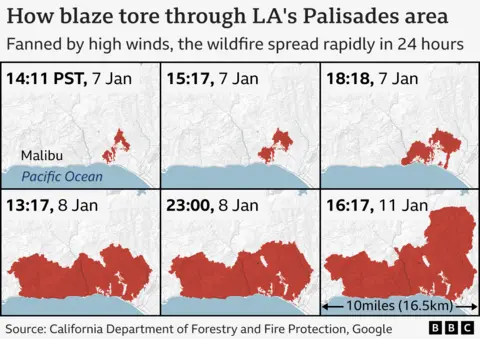
What role has climate change played?
Although strong winds and lack of rain are driving the blazes, experts say climate change is altering the background conditions and increasing the likelihood of such fires.
Much of the western United States including California experienced a decades-long drought that ended just two years ago, making the region vulnerable.
"Whiplash" swings between dry and wet periods in recent years created a massive amount of tinder-dry vegetation that was ready to burn.
US government research is unequivocal in linking climate change to larger and more severe wildfires in the western US.
"Climate change, including increased heat, extended drought, and a thirsty atmosphere, has been a key driver in increasing the risk and extent of wildfires in the western United States," the National Oceanic and Atmospheric Administration says.
Fire season in southern California is generally thought to stretch from May to October - but the Governor Newsom has pointed out earlier that blazes are now a perennial issue. "There's no fire season," he said. "It's fire year."
How long will the fires last?
No one can say when the Los Angeles fires will finally go out. The city is bracing for continued burning and a possible spread amid the latest wind warnings.
The Santa Ana winds that fanned the flames are set to strengthen, with strong gusts on Tuesday before the severity is expected to drop. There are now new red flag warnings for dangerous wind storms.
The other conditions that fed the fire - dry brush and lack of precipitation - continue as well.
BBC

